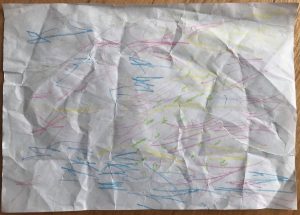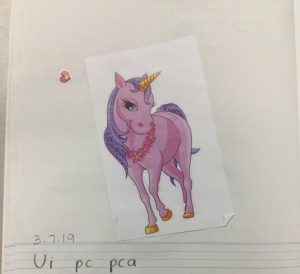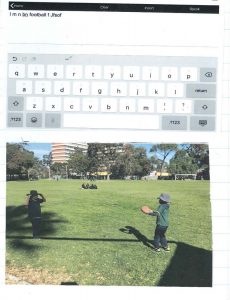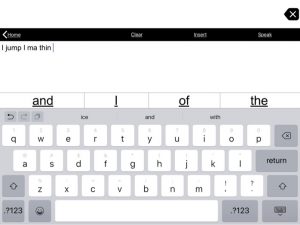
In my last writing blog post, I talked about using writing data walls to keep track of whole school writing progress - and, of course, each and every individual student's progress as part of this.
The Developmental Writing Scale (Sturm et al 2012) is a key part of this. This scale is so useful as it allows us to track a student's writing progress from emergent to conventional with a 14 point scale. Most importantly it also has accommodations listed for students who use alternative pencils - which is important for most of the students I work with.
We prefer to use the Developmental Writing Scale through a moderation process - with 2 or more staff rating three or more writing samples from each student. We also want to ensure that the student is given an opportunity to write with different pencils - just as we write with different pencils each day. I am typing this blog post on a computer, but earlier today I wrote several text messages on my phone and I even used handwriting to add to my shopping list on the fridge. Each of these pieces of writing are very different in style, complexity and purpose and would get very different scores on the Developmental Writing Scale. We want each student to have a chance to put their best piece of writing forward - so we want them to do free writing with the easiest possible pencil for them. In terms of the three samples, I prefer that at least 2 of them are written with alternative pencils and if all three are with alternative pencils then that's fine! Handwriting is always optional.
And just to refresh everyone's memory - there's a writing sample collection form in last blog post if you want to refer to it.
Once we've collected the samples then we moderate them. We remove the students' names from the samples so that we minimise the risk of expectations influencing moderation - and at many schools moderation is done as a whole school process, or several staff do their classrooms together. The sample is shown then rated by the group. The lowest score that anyone in the room gives the sample, is the one that it receives. Sometimes there is a considerable debate about this and people work to persuade others to their point of view - and we usually let this happen for a short period and then call for final votes! Some samples, however, are easily scored and we move on quickly.
The Developmental Writing Scale
As I said earlier, the Developmental Writing Scale is a 14 point scale that goes from emergent to conventional and then through the early stages on conventional writing - in the Australian Curriculum the highest level on the scale is at a grade 3 and 4 writing level. We use the level descriptors to decide what level each piece of writing is at - and then those level descriptors help us to work out what skills we need to teach them to move to the next level.
And now, to demonstrate how this process works, let's look at each level on the scale along with examples.
Level 1
Drawing - lines and curves that appear to represent objects. Accommodations: Selection of a picture by a [student] who cannot hold a traditional pencil or marker. (Sturm et al, 2012)
If we go back to my blog post called Emergent Writing: Focus on Function, this is how we would rate Mathilda's first "writing sample" - which I have also put below. This is the stage at which an individual doesn't recognise the difference between writing and pictures - and this is the point at which we (the adults) do lots and lots of attributing meaning and assuming competence to teach them them that they are a writer. Then we continue to use those same two adult superpowers to teach them that print has meaning and that everything they say they can write. Frequent writing practice with adults attributing meaning and assuming competence is how individuals move to the next point on the scale.


The accommodations part of this scale is REALLY important for any student using a keyboard or flip chart. A sample collected with these alternative pencils, and which is scored at level 1, needs to be accompanied by an extra task with the student. Basically, we provide the student with some writing and a picture. The easiest way to do this is to use a children's picture book. I prefer to use one which has writing on one side and a picture on the other. I then ask them to "show me the writing". If they select the picture, then they are rated as a level 1. The reason for this task being so important will become apparent as we get to level 3 on the scale.
Level 2
Scribbling - Continuous vertical, circular or wavy lines arranged linearly across the page, which may include letter-like forms, but with the majority of shapes not recognizable as letters. Accommodations: if an [individual] uses a keyboard [or flip chart], this level would not be used. (Sturm et al, 2012)
For individuals with good fine motor skills, this is where they start to demonstrate that they have had enough experiences with text to know that there is a difference between print and picture - and then this starts to show up in their writing. Below is a perfect example of this stage. This is an old sample that my friend Dianne sent me - a letter from her nephew to his grandmother.

Again, the accommodation part of the scale for level 2 is really important - and this is basically that if the student is using an alternative pencil, then we don't see level 2 in their writing development - they jump straight from level 1 to level 3.
Level 3
Letter Strings (no groups) - Handwritten or typed strings of letter but not grouped into words. Accommodations: alphabet display (e.g. paper copy) and standard or electronic keyboard access (e.g. on screen keyboard or AAC system) (Sturm et al, 2012)
For a student holding a pen or a pencil, this is where they show us that they've learned enough about text to know that it is composed of letters - and so we start to see those letters in their writing. For students who are using a keyboard or a flip chart, we've already been seeing letter strings because their alternative pencil is setup for them to write with letters. BUT remember the accommodation from level 1. If we do that separate "show me the writing" task with them and they select the picture, then we would rate their sample as level 1. If they show us the writing, then we rate their sample as a level 3. And the accommodation from this level is a lot easier - it's just suggested alternative pencils that writers can use. Just remember no matter what level you are at you need to have access to all the letters of the alphabet.


Level 4
Letter Strings Grouped in Words - Strings of letters grouped into "words" (ie with spaces between at least two groups of letters) but with no intelligible words. Accommodations: Alphabet display (eg paper copy) and standard or electronic keyboard access (e.g. on screen keyboard or AAC system) (Sturm et al, 2012)
This is the level where a developing writer shows us that they have learned one more thing about writing - which is that they know that as well as letters there are also spaces. It should look very similar no matter what pencil is being used!

Level 5
Strings of letters grouped into "words" with only one possible real word (ie two or more letters in length) set apart, written repeatedly or embedded in a string of letters. Accommodations: Word bank or word prediction software. (Sturm et al, 2012)
And now developing writers have paid enough attention to text, that they incorporate one real word into their own writing. The real word has to be two or more letters - so you can't count "I" or "a" . Sometimes we find that the one real word is a high frequency word, and sometimes it's a high interest word. Oh - and you might also see spaces disappear again at this point.

Level 6
Two or three different intelligible words - Two or three different intelligible words embedded in strings, separated by spaces, or in a list format. Single letter words such as "I" and "a" must be separated by spaces to count as an intelligible word. Accommodations: Word bank or word prediction software. (Sturm et al, 2012)
At this level, many writers are now spelling words phonetically. We also get some writers who meet all the criteria for this level who spell their two or three words perfectly as they develop more and more sight words. For a sample to be rated Level 6 there are also a couple of rules about spaces. The first Level 6 space rule is that spaces don't have to be there! The main example within the scale is : IYTKTOSMNTHETR (I like to swim under water). There isn't a single space - and that's fine. The second rule of spaces is that if you want to count I or a, you need it to be separated by a space from any surrounding words - otherwise it's too easy to do them by chance.

cat eat fla.
Level 6 Sample. typing. "cat eat fly"
Level 7
Three or more different intelligible words in a list - Three or more related words. Accommodations: Word bank or word prediction software. (Sturm et al, 2012)
This is often one of the easiest levels to identify. There are usually a lot of nouns in the sample and there are usually no "little words". The two rules about spaces from Level 6 are also still in force.

Level 8
Partial sentence of more than three words - More than three different intelligible words, with at least two of them in a partially formed sentence (ie gramatically related parts of a phrase, clause or sentence). Accommodations: Word bank or word prediction software. (Sturm et al, 2012)
The description says it all! It's also worth knowing that spaces are still optional at this stage.
Philip and Jayden playing you no
Level 8 Sample, typing "Philip and Jayden playing Uno"
Atthpiooltogoswimmig
Level 8 Sample, typing "At the pool to go swimming"
Level 9
One to two complete sentences - Sentences have a subject phrase and a verb phrase. End punctuation is not necessary. Accommodations: Word bank or word prediction software. (Sturm et al, 2012)
Follow the level description - and remember spelling doesn't have to perfect, it just needs to be at a level where the intended audience can read the piece of writing. This is also the first level where spaces are needed between words - and they need to be used for the future levels too.

Level 10
Three or more unrelated sentences (neither coherent nor cohesive) - Sentences have no coherent topic (ie sentences are not related). Accommodations: Word bank or word prediction software. (Sturm et al, 2012)
For this level, we want to see end punctuation. We also need to remember that spelling still doesn't have to be perfect - just at a level where the intended audience can read it. And this rule also applies to the last four levels. Always remember that we teach spelling and words in the working with words block - not within writing.

Level 11
Three or more related sentences (coherent but limited cohesive) - Organized writing with three or more sentences on a coherent topic but with limited cohesion between sentences (ie sentences can be reordered without changing meaning). Accommodations: Word bank or word prediction software. (Sturm et al, 2012)

Level 12
Three or more related sentences that cannot be reordered (coherent and cohesive) - Organised writing with a coherent topic (ie on a consistent theme) and use of cohesive devices (eg pronoun or synonym replacement, logical connectors, subordinating conjunctions, conclusions that refer to prior content) across three or more sentences so that sentences cannot be reordered without meaning. Accommodations: Word bank or word prediction software. (Sturm et al, 2012)
On Thursday 2nd or August I went to the basketball carnval at Pdsadena high school. on the Photo I am sitting with my mate. I am happy. We one six games and lost one game. I scored somes three ponters. I would love too join a basketball team.
Level 12 Sample, typing
Level 13
Two coherent paragraphs of at least three cohesive sentences each - organised writing with a coherent main topic and two cohesive subsections (subtopics or story parts) with at least two sentences elaborating the meaning of each. Accommodations: Word bank or word prediction software. (Sturm et al, 2012)

Three or more coherent paragraphs of at least three cohesive sentences each - organised writing with a coherent main topic and at least three cohesive subsections (subtopics or story parts), with at least [three] sentences elaborating the meaning of each. Accommodations: Word bank or word prediction software. (Sturm et al, 2012)
My long weekend
On Friday, I watched the two spare garbage trucks. One was doing the garbage, the other was doing the recycling. They were both white ones. They met together on my street. The recycling came before the garbage. It was good. I also went out with mum and dad for a drive. I saw a few buses which were 769, 791, 773, 776, 755, 1755, 1471, 1210, 2456, 2554, 2515, and 1810. It was a good day.
On Saturday I went shopping with mum and got stuff from coles before Showdown 45. The power lost to the crows. The power should have won.
On Sunday I went for a drive with mum and dad. We drove past Pasadena High School where I went for the Basketball carnival. It was a good drive.
I had a great weekend.
Level 14 Sample, typing
And that's the whole scale! Hopefully those explanations and examples have helped you in scaling your students' writing.
And the next blog post will be focusing on using the scale to teach to the next level.
Thanks to:
- Mathilda and family
- Dianne and her nephew
- The Grove Education Centre students and staff
- Rosella Park School students and staff
- Adelaide North Special School students and staff
Reference
Sturm, J., Cali, K., Nelson, N.W., & Staskowski, M. (2012). The Developmental Writing Scale: A new progress monitoring tool for beginning writers. Topics in Language Disorders, 32(4), 297 – 318.



Pingback: Teaching to the Next Level: Using the Developmental Writing Scale to guide instruction | Jane Farrall Consulting
Pingback: Building Language Through Emergent Writing: #AGOSCI2019 | Jane Farrall Consulting
Pingback: Using the Developmental Writing Scale. #AGOSCI2019 | Jane Farrall Consulting
Rosemary
jane